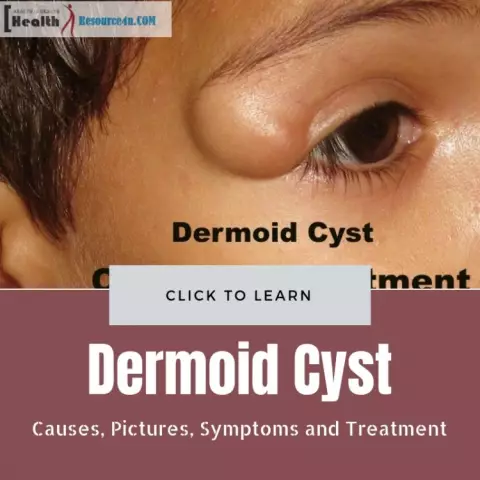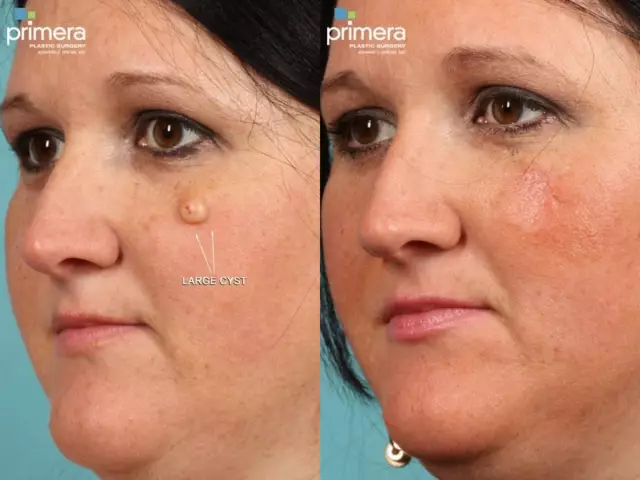- Author Rachel Wainwright [email protected].
- Public 2023-12-15 07:39.
- Last modified 2025-11-02 20:14.
Spine cyst

Aneurysmal bone cyst of the spine occurs mainly in young people. The main symptom of a spinal cyst is severe back pain. Localization of the neoplasm can be very different: a cyst of the thoracic, cervical, sacral, lumbosacral or lumbar spine. In most cases, a cyst forms in the area of arches or roots and only rarely in the body of the vertebrae.
Outwardly, a cyst is a formation filled with blood inside. The main cause of cyst formation is hemorrhage and hypodynamic bone disorder. This is accompanied by the appearance of chronic pain in the spine, which can only be relieved by the use of painkillers.
Spinal cyst diagnostics
To diagnose a cyst of the spine, it is necessary to conduct a number of studies. The patient must be prescribed magnetic resonance and computed tomography, biopsy, ultrasound.
Spinal cyst treatment
As a rule, the treatment of a cyst of the spine is carried out only by surgery, i.e. remove the cyst of the spine. Undoubtedly, spinal surgery is associated with the development of various complications, but today there is no other alternative way.
The operation itself to remove the cyst of the spine is quite difficult and should only be performed by a very experienced surgeon, as this will minimize the risk of complications. During the operation, you must be extremely careful, as bleeding may occur.
There are two types of surgery. With intratumoral curettage, the contents are sucked out of the cyst. However, after such an intervention, a recurrence of the cyst almost always occurs. Therefore, in order to avoid relapses, the most effective treatment is complete excision of the spinal cyst. The operation to remove the cyst of the spine involves opening the wall of the cyst, suctioning fluid from it, after which the cyst shell is completely removed.
If spinal surgery is contraindicated for a patient for any reason, the doctor may refer the patient to undergo a course of radiation therapy or radiation therapy. Such procedures involve the introduction of special preparations into the cyst's body. This procedure also carries a certain risk as it can damage the spinal cord.
If not one, but several small cysts are observed in the spine, then the patient should undergo periodic examination by a surgeon. Sometimes these small cysts resolve on their own without specific treatment. If the doctor discovers that the cysts begin to increase in size, immediate surgery or treatment is required.
Types of spinal cysts
Perineural cyst of the spine
A perineural cyst of the spine is a neoplasm in the lumen of the spinal canal that compresses the spinal nerves, causing severe pain. These cysts are filled mainly with cerebrospinal fluid (cerebrospinal fluid), and they are formed as a result of the expansion of the spinal nerve. This happens, as a rule, due to a spinal injury and impaired movement of the cerebrospinal fluid. A perineural cyst is also called a cerebrospinal fluid or arachnoid cyst of the spine. If the formation is small, then the symptoms of a cyst of the spine usually does not cause. But as it grows, it begins to press on the nerve endings extending from the spinal cord, which manifests itself in weak or severe neurological disorders.
The main symptom of a perineural cyst is pain that occurs during prolonged sitting, walking. There are also pain in the buttocks, sacrum and lower back, abdominal pain and headache. The patient may have problems with the bladder, constipation, tingling, and "creeping" on the feet and legs.
If the cyst has reached 1.5 cm or more, its removal is usually prescribed. After opening the cyst, its contents are removed, and a special fibrin glue is applied to fuse the cavity and prevent recurrence. Sometimes the cyst root is completely removed, capturing a thin plate of the vertebra. These operations are fraught with various complications: loss of liquor fluid, aseptic procedural or bacterial meningitis.

Non-surgical treatment of cysts of the spine consists in the appointment of anti-inflammatory drugs and physiotherapy methods. Such treatment can reduce the symptoms of a cyst of the spine, however, before starting treatment, a consultation with a doctor is necessary.
Periarticular cyst of the spine
A periarticular or paraarticular cyst of the spine is a cyst that is located near the facet joint, extending from it or growing into the yellow ligament. These cysts include the ganglionic and synovial cysts of the spine.
A synovial cyst forms on the posterolateral surface of the spinal canal, and inside is lined with synovial epithelium.
The ganglionic cyst is predominantly formed in the periarticular zone and is in no way connected with the joint, and also has no synovial epithelium.
The cause of the formation of a synovial cyst is the bulging of the bursa in the intervertebral joint. As a result, a cavity is formed that fills with synovial fluid. This can be facilitated by various factors: a congenital anomaly in the development of synovial tissue or an inflammatory process that changes the intervertebral joint, etc.
A synovial cyst may not have any symptoms for a long time. Mostly it is treated with the use of non-steroidal anti-inflammatory drugs, physiotherapy, periarticular steroid injections. If, after the treatment of the cyst of the spine, the patient has a relapse, an operative treatment is prescribed.
YouTube video related to the article:
The information is generalized and provided for informational purposes only. At the first sign of illness, see your doctor. Self-medication is hazardous to health!






